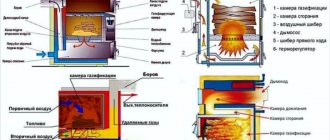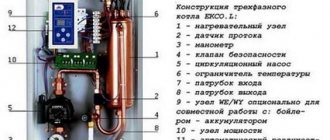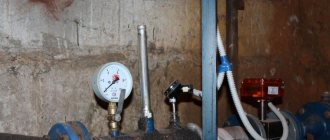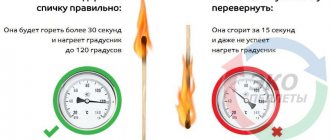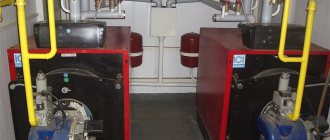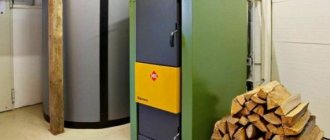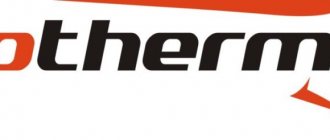Hot water boilers
Design and principle of operation of hot water boilers
A hot water boiler is
a device that has a firebox, heated by the products of the fuel burned in it, and is designed to heat water under pressure above atmospheric pressure and used as a coolant outside the device itself.
The heat generated by hot water boilers is used for heating, ventilation and hot water supply, and can also be used for various technological needs.
The maximum water temperature, depending on the heating output of the boiler, at the outlet of the boilers can be 95, 115, 150, 200 °C.
All water heating boilers can be divided into gas-tube boilers
(with smoke and flame pipes) and
water pipes.
In gas-tube boilers, hot gases move inside pipes washed from the outside with water;
in water-tube systems, water moves through the pipes, and flue gases move outside them. Based on the material from which hot water boilers are made, they can be divided into steel
and
cast iron.
Cast iron boilers are more resistant to corrosion.
By the nature of water circulation (regardless of design), all hot water boilers are direct-flow
, i.e. with a single movement of water through its individual elements.
A hot water boiler consists of a combustion device and heat-receiving surfaces, which for water-tube boilers are divided into combustion screens made of separate panels, which are a series of parallel pipes connected by input and output manifolds, and convective heating surfaces assembled from coils.
Of all the heating equipment that is used today in everyday life, solid fuel boilers have been known for a long time. Due to the simplicity of their design and operating principle, and the availability of fuel, units of this type have become widespread. Today, for many residents of private houses in rural areas, such equipment has become a kind of “lifesaver.” The constantly rising price of household gas and difficulties in obtaining permits for the installation of a gas autonomous heater contribute to the fact that today, at a minimum, solid fuel boilers have not lost their demand among the population living near forested areas as a source of firewood.
Today, there are two options to solve the problem of autonomous heating using solid fuel: buy a ready-made factory product or make a solid fuel boiler with your own hands. The cost of a modern high-tech heating unit is quite high, but the price range is wide - from 3 to several tens of thousands of rubles, which makes the device accessible to a wide range of consumers.
If you have certain technical training, you can assemble a solid fuel boiler yourself, using diagrams and recommendations for making models of these devices, which are the most popular for DIY installation.
Factors that ensure efficient operation of the device
There are several requirements that must be met for the hot water boiler to operate efficiently.
Before describing the main design and technical characteristics, it is worth highlighting several main indicators that affect the quality of work, which are considered general and are suitable for any device.
These include the operating diagram of the hot water boiler and parameters such as:
- Equipment manufacturer.
- The quality of the device and its elements.
- Availability of a warranty period for operation and maintenance of equipment.
To operate efficiently, you need to pay special attention to the firebox.
It must have a sufficient volume to burn the entire volume of loaded fuel. According to experts, this parameter is an important calculation indicator that determines the total amount of mechanical fuel.
Solid fuel boiler concept
A homemade autonomous boiler running on solid fuel is, by and large, an ordinary stove installed in a barrel of water. The main task of such a device is to heat boiler water using the heat from the combustion of wood or coal, which will be supplied to home heating radiators.
But such a device, which is tempting to make yourself due to its primitiveness, will not be effective in terms of heating and will not be profitable due to high fuel consumption - the simplest boiler designs have an efficiency of only 10-15%.
Primitive solid fuel water boiler with chimney economizer
Important! The operation of a solid fuel heating boiler depends on the quality of the draft and, accordingly, the supply ventilation. Even a well-made boiler will not be able to provide effective heating of the room if the ventilation is not arranged appropriately.
Homemade boilers are assembled not only from metal, but also from brick. Brick devices are usually built in country houses, where higher demands are placed on the aesthetics of the installed equipment than in utility or technical premises.
Metal boilers are the simplest devices, the manufacture of which allows the use of available materials and is possible with the help of available tools. But it does not follow from this that their production and installation can be carried out without, at a minimum, sketches of workpieces and components, as well as clearly developed technology - sequence, methods of performing individual stages of preparatory and main work.
Choosing a heating boiler design
Heating stoves and solid fuel boilers, although the combustion processes are similar, differ in functionality. A heating boiler, unlike a furnace, must not only heat the room at the installation site by burning wood or coal, but also supply the heating circuit with heated coolant. But to accomplish the second task, it is not enough to place a heat exchanger (a section of the heating circuit) in the furnace - it is also necessary to ensure the continuity of fuel combustion and uniform coolant circulation through this coil.
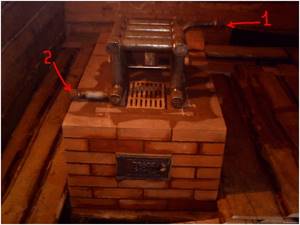
Tube heat exchanger for a solid fuel boiler made of refractory bricks
What boiler design should you choose to make it easier to make it yourself, what difficulties will you encounter during the work process? These questions can be answered at the design stage. Drawings of homemade solid fuel boilers give a sufficient idea of what a particular design looks like and what you should pay attention to during the manufacturing process.
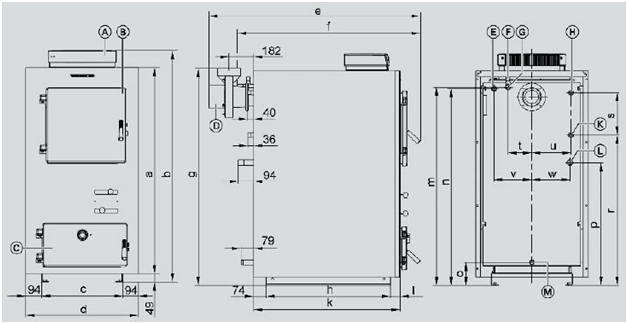
An example of a schematic representation of a solid fuel boiler from the outside: front, side and rear views.
Each type of boiler equipment operating on solid fuel has its own design features and manufacturing nuances. When planning to independently assemble a heating unit, you need to decide which design to give preference to - with a lower or upper (shaft) combustion method.
Units with bottom combustion are equipment in which the door for loading firewood is located in the upper part of the combustion chamber, but fuel combustion occurs from below, as a result of which the upper layers of the stack move downward under their own weight, and afterburning of the smoke occurs in the upper part. Depending on the model, air movement through the firebox occurs from the bottom up, either forced (fan) or naturally (draft), which results in independence from the electrical network, but reduced efficiency and a smaller volume of loaded fuel.
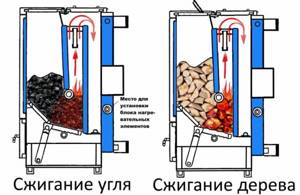
Schematic cross-sectional representation of a solid fuel boiler with bottom combustion of fuel
In solid fuel boilers of shaft construction, firewood is loaded through the door, which is located in the upper part of the combustion chamber. Such units are equipped with forced draft, which is directed from top to bottom - it drives smoke into the lower part of the firebox, where it burns mixed with air, and along the way it heats up and additionally dries the fuel of the lower tiers.
Combining a boiler with a heating water system
A system of pipes and radiators connected to the water circuit allows the heat to be evenly distributed over the entire area of the building. The simplest type of heat exchanger can be a water reservoir, when a heat source is located directly below it. But such heating is ineffective, since the liquid will be heated only from below.
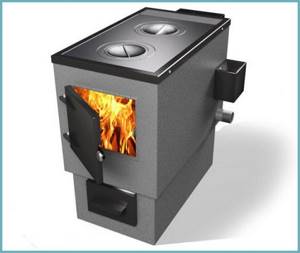
The so-called “water jacket” will be much more effective in terms of transferring thermal energy. A more complex type of water circuit consists of double top and walls along the entire contour of the boiler, inside which the coolant circulates. Due to constant circulation, the water does not stagnate, and the thickness of 3-5 cm between the walls allows the liquid to warm up as quickly as possible.
Another equally effective type of water circuit is welded from thick steel pipes, bent in waves along the walls and top of the combustion chamber like a “coil”. The coolant moves slowly through pipes with a diameter of 5-6 cm, providing excellent heat transfer. In addition, this type of circuit has an important advantage - improved maintainability.
Control and monitoring unit
The boilers are equipped with special systems to regulate the water temperature in the water circuit. The simplest system is based on the operation of a thermostat - when the required temperature is reached, the blower damper is closed and thus the air flow is reduced. As soon as the water cools down, the system will work in reverse.
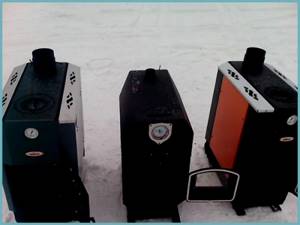
More advanced control systems work with the inclusion of precise temperature sensors and forced electrified air supply. When installing forced ventilation, air is supplied from above, due to which the fuel is burned almost completely. Boiler equipment of this type needs to be connected to the electrical network, but in the absence of electricity it is not able to work.
Equipping a circulation pump can save the system from completely defrosting. A boiler left unattended in winter, having used up all the fuel, will not be able to maintain the temperature level of the water in the system for a long time, as a result of which it will freeze over time. In this kind of critical situation, the control system will turn on the circulation pump, which will lead to the circulation of the coolant - in mild frosts, running water will not freeze.
Basic requirements for the design of a homemade heater
In its classic form, the heating unit from which home heating will operate consists of the following elements:
- combustion chamber (bunker) for burning wood, coal, fuel briquettes;
- grate bars through which air mass is supplied to the combustion chamber;
- tubular-type heat exchanger or storage tank for boiler water;
- chimney for removing fuel combustion products to the outside;
- draft regulator
An important requirement that will have to be taken into account at the boiler design stage is the size of the combustion chamber. The firebox of an autonomous solid fuel boiler should be spacious and roomy. The design of the combustion chamber is calculated in such a way that the fuel placed in it burns completely without additional mixing. Brick boilers are preferable in this regard, since brick has lower thermal conductivity, which ensures a higher combustion temperature in a ceramic firebox than in a metal unit.
The combustion chamber must be designed in such a way as to maximize the concentration of thermal energy on heating the heat exchanger.

Solid fuel boiler steel firebox
The next, no less important aspect when designing heating equipment is the heat exchanger of a solid fuel boiler. The efficiency of boiler equipment depends on the design of this element, the quality of the material and the execution. The name of the heat exchanger is determined by the material of its manufacture - cast iron or steel. The heat exchange coils of these units are tubular structures with vertical or horizontal pipes in common usage, often called water jackets.
We will not consider cast iron heat exchangers, since this is a cast structure, the manufacture of which is impossible at home. However, you can use ready-made cast iron components removed from old units that were dismantled for some reason. Such a replacement is common when a solid fuel boiler is being modernized or repaired.
To make a steel heat exchanger, thick-walled pipes are used. The pipe is given the desired configuration by bending it under heat or using bends or half-bends of the appropriate diameter, connected to the coil fragments by electric welding.
The coil installation diagram for a traditional solid fuel unit will give a complete idea of what the heat exchanger should look like and in what position it is best to install it.
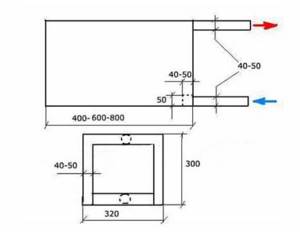
Sketch of one of the options for placing a tube heat exchanger in the housing: side views
Design Features
Boiler equipment of this type, in fact, is a slightly modified version of standard boilers - the design additionally includes a water circuit.
- firebox;
- grate;
- ash chamber;
- water circuit.
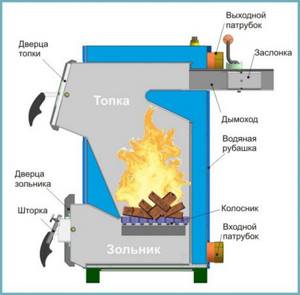
If single-circuit models are intended only for heating rooms, then double-circuit models are used both for heating the building and for supplying it with hot water.
Advice. Before purchasing a dual-circuit model, you should calculate the power that will be spent not only on heating the room (about 1 kW per 10 sq. m.), but also on heating hot water.
Fuel loading can be done manually or automatically. The second option involves having a reservoir in the boiler into which fuel is added every 3-7 days. But models are more expensive than those with manual fuel supply, and therefore less common.
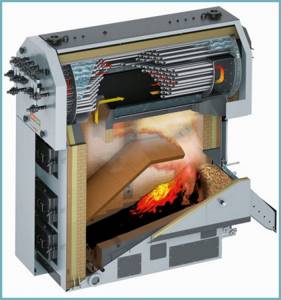
In addition, only fuel that has undergone special preparation is suitable for supply - coal up to 2.5 cm or the so-called “eco-peas”. Some models are equipped with built-in electric heaters that start up when the fuel supply is cut off, thus ensuring their continuous operation.
Step-by-step production of a solid fuel boiler. Subtleties and nuances
You will not be able to make the most economical homemade solid fuel boiler, but you can create a heating apparatus that is quite suitable for heating and hot water supply. The fact is that the assembly of industrial products is carried out on high-precision industrial equipment from specially selected materials in compliance with technological parameters. Each factory boiler model is based on accurate thermal calculations. The possibilities of working at home are incomparably more modest than in industrial conditions, therefore, when choosing a model to be manufactured, one must proceed from existing realities, including one’s personal potential as an installer.
Tools and materials
Having a drawing and specification of the heating unit, you can determine the list of necessary tools. Whether you want to make a large boiler or plan to assemble a small solid fuel heating device for your dacha with your own hands, the list of accessories will be approximately the same.
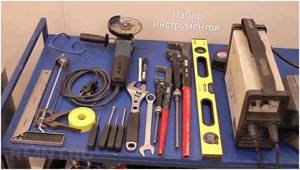
Tool kit for self-production of a solid fuel heating unit
To work you will need the following tools and accessories:
- welding machine;
- small grinder with cutting and grinding discs (safety glasses);
- electric drill with metal drills;
- gas keys No. 1, 2;
- hammer;
- a set of open-end or ring wrenches and screwdrivers;
- pliers;
- 90 degree square
The main material in production is steel, the thickness of which for the boiler must be at least 5 mm, for grates - from 7 mm.
In addition, you will need:
- steel corner 50x50 - for the boiler frame;
- sheet stainless steel - if there is a storage tank in the design;
- thick-walled steel pipes with a diameter of 32-50 mm - for the manufacture of a coil heat exchanger.
A complete list of materials and their consumption is prepared in advance on the basis of technical drawings.
Manufacturing of the housing and heat exchanger
The boiler body, which often acts as a combustion chamber, is the basis of the entire structure. To reduce the deformation of the walls under the influence of high temperature, the enclosing structures of the firebox are made in two layers with a backfill between the layers of dry sifted sand, which plays the role of a geometry fixator. The outer and inner shells of the firebox are made of frames, which also increases the rigidity of the structure. In addition, to increase the strength of the combustion chamber wall, the outside can be sheathed with a steel angle or profile in the form of stiffening ribs.
How to make an exhaust boiler with a water circuit with your own hands
In order to complete this unit yourself, you need to stock up on the following materials:
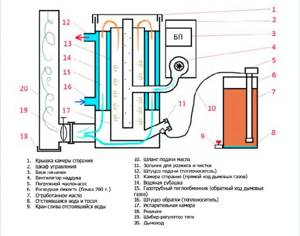
Diagram of an exhaust boiler with a water circuit
- sheet metal for the tank (thickness 4 mm);
- sheet metal for the lid (thickness 6 mm);
- chimney pipe;
- oil pump;
- fan;
- steel adapters;
- heat-resistant sealant;
- metal corners for supports.
- grinder with a circle for cutting metal;
- pencil and construction tape;
- drill with metal drill bit;
- hammer and set of keys;
- welding with electrodes.
To make work on the boiler easier, you can take ready-made barrels for propane or oxygen.
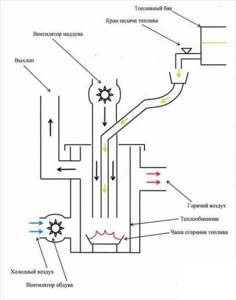
Boiler in testing diagram
They will provide heat to huge areas! Industrial gas boilers for heating, their operating principles
The high demand for domestic and industrial gas boilers is due to their high efficiency, cost-effectiveness and safety.
A modern gas boiler is capable of heating a room, heating the coolant and generating steam for industrial needs.
The complex design of the firebox allows for high efficiency with low gas consumption, and thick walls and alloy steel make the device durable.
Odnoklassniki
The operating principle of the heating device is based on the combustion of gas in a firebox with accompanying heating of the coolant. Based on this feature, boilers are divided into two groups:
- with hot air circulation (fire tube);
- with heating of the liquid almost to the boiling point (water tube).
Steam boilers are installed in enterprises that use steam in industrial production.
Reference. The cost of natural gas and its calorific value have no competitors among other natural combustible materials. Therefore, the use of natural gas provides significant economic benefits.
Gas-burner
The main part of any boiler is the burner. They are divided according to the type of gas supply:
- to injection systems that suck in gas along with an air stream;
- to supercharged ones, using forced air injection by a powerful fan;
- to diffuse ones, supplying gas to the combustion site through special diffusion channels.
Photo 1. Industrial gas boiler of the Entroros brand. The device has a pressurized gas burner.
A common burner design is a set of several parallel rod devices that are located evenly throughout the entire volume of the firebox. They are equipped with holes to allow the mixture of gas and air to escape and ensure uniform heating. To increase efficiency, a coolant pipeline is placed between the rods. Such installations can achieve an efficiency of 98-99%.
Another popular burner option for an industrial boiler with a power of 100 kW and above has a flare device. A special nozzle is installed on one of the walls of the unit into which the gas-air mixture is injected. Flare combustion has proven itself well in two- and three-pass boilers; it is used to produce coolant with a temperature of 115-120 degrees or steam.
Combustion chamber
To fire a powerful boiler, it is important to maintain high temperatures for a long time. Heat resistance is ensured by the use of special steels with the addition of manganese, chromium and other alloying components. The walls are reinforced with corrugation and surrounded by a heat-insulating shell.
In hot water boilers, one or two heat exchange circuits are placed in the firebox through which the coolant circulates.
Steam or high-pressure boilers use combustion screens and a heat exchanger to produce heat, and steam is produced in the chimney, where the temperature of the flue gases is reduced to 600-800 °C.
A separator and a superheater are placed in the combustion chamber of a steam boiler.
Operational safety is ensured by an explosion valve, which must be installed on one (usually the rear) wall of the boiler. The mechanism is triggered if the pressure in the firebox exceeds.
Automation and control system
The complexity of controlling an industrial boiler is associated with constantly changing temperature and water pressure, instantaneous gas consumption, air intake for the burner and other factors.
To eliminate the human factor, all control is carried out using special controllers.
Data for their operation comes from temperature, pressure, air and gas flow sensors. For greater reliability in modern boilers, the automation is divided into two parts:
- Automatic fuel supply, which is responsible for the operation of the modulation burner and maintaining stable operation of the entire system.
- Safety automation takes into account the critical operating conditions of the boiler, the presence of a flame in the firebox, gas supply, and heating of the coolant. In the event of a malfunction, the boiler is switched off and the fuel supply is stopped. Some boiler models are equipped with self-diagnosis systems.
Attention! Natural gas is usually used: methane. It is lighter than air and is the optimal fuel. In some cases, combustion of a propane-butane mixture is allowed. This gas is heavier than air and requires appropriate equipment adjustment.
What is a gas boiler room?
Before considering the operating principle of a gas boiler room, you need to get acquainted with what is hidden behind this word. A private boiler room is called differently - a furnace room or a boiler room, but its essence does not change: it is a set of devices, a system in which natural or liquefied gas is burned and heat is generated. The heat is transferred to other building systems. Sometimes in gas boiler houses the coolant is not heated, but steam is created, but this applies to systems operating in food enterprises.
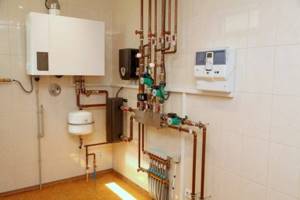
A boiler room is a separate room, which is intended for the installation of heating and/or hot water equipment with a power of up to 350 kW. There is no lower limit. However, according to the standards, a unit with a power of more than 60 kW is the reason why a separate non-residential premises must be provided in the house design. The power of gas equipment over 150 kW requires the placement of a boiler room on the first or ground floor, in a separate building or an extension.
What is included in the boiler room?
The gas boiler room houses all the equipment: main (boiler, boiler) and auxiliary. The last category includes:
- distribution manifolds that regulate media parameters in multi-circuit heating systems;
- safety group with an expansion tank and mandatory elements - safety valves;
- chimney, high-quality, efficient forced ventilation system;
- The device that ensures the movement of the coolant is a circulation pump.
The simplest models of gas boilers include:
- a burner designed to burn fuel;
- heat exchanger that transfers heat to the circulating fluid;
- a control unit that controls the fuel combustion process.
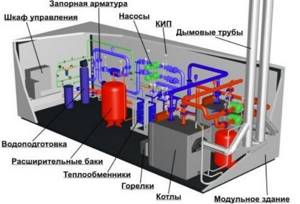
More complex gas equipment uses additional elements:
- fans, pumps;
- safety valves;
- tanks intended for liquids;
- electronic complexes - control boards.
Mandatory components of a gas boiler room located in the basement, basement or extension are gas control systems and sensors. They are also required for any equipment whose power exceeds 60 kW.
There is a limit on the number of devices in one gas boiler room: there can be no more than four, but the total power should not exceed 200 kW. This requirement is mandatory, so before purchasing, find out the performance of each selected model.
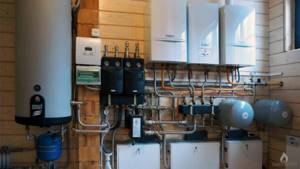
The main heating unit can be either wall-mounted or floor-mounted. The first devices are characterized by low power, so they do not require the arrangement of a separate room. The second designs, on the contrary, are more often installed in boiler rooms. Equipment can be:
- single-circuit, intended only for the heating system;
- double-circuit, performing two functions: preparing water for hot water supply and heating.
The combustion chambers of boilers are divided into open and closed, or turbocharged (usually in wall-mounted units). In the first models, air intake occurs due to natural draft. The set of gas boilers with a closed combustion chamber includes a coaxial chimney with a fan-exhaust fan. This element solves two problems at once - it removes combustion products and brings in fresh air from the street.
If the area of the boiler room allows, then other large household appliances, boilers, heat accumulators, and filtration systems are installed in it. An essential element is an electrical panel. Regardless of the power of the equipment, the ceilings, floors and walls of the room require finishing with non-combustible materials.
The difference between the boiler room and other rooms
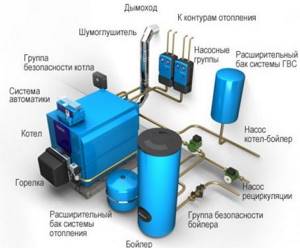
The equipment of a gas boiler room is quite different from ordinary utility rooms. It must contain a whole set of additional elements.
- A chimney designed for the rapid removal of combustion products. The low power of gas equipment (up to 30 kW) allows it to be installed through the wall of the boiler room. For more productive equipment you need a full chimney through the roof. The minimum number of horizontal (short) sections is a mandatory condition.
- Pipes for supplying water and coolant to devices (boilers, boilers) operating in the boiler room, shut-off valves.
- Sewage pipelines for scheduled or emergency drainage of water from systems.
- Effective ventilation system: both natural and forced.
- Instrumentation for accounting of all resources.
Since any gas boiler room remains a potentially dangerous room, it needs a window (or several) designed to illuminate and ventilate the room in the event of gas contamination or an accident.
Boiler rooms and premises for them
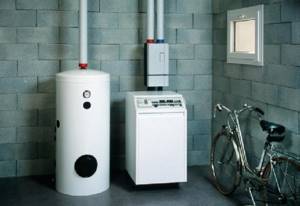
All gas boiler houses located in private houses are divided into internal, attached or free-standing. Inside the house, boilers are often installed in kitchens. However, for a large amount of additional equipment, it is necessary to allocate a sufficiently spacious room - a separate room. This method implies minimal costs for organizing a boiler room.
Units operating on main gas can be installed in any non-residential premises. The exception is devices that are connected to liquefied gas cylinders. They cannot be installed in basements or basements. A boiler room attached to a building provides a chance to reduce costs. The entrance is often made not only from the outside, but from the house, guaranteeing maximum convenience.
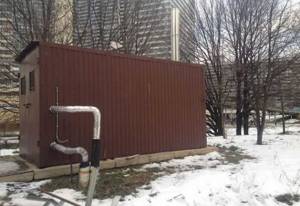
Free-standing gas boiler houses are considered optimal. This arrangement is especially recommended if the total power of the equipment exceeds 200 kW. In this case, the gas installation will be as safe as possible, and the noise of operating appliances will not annoy residents. This option has only one disadvantage - the high costs required to create an additional structure. A relative disadvantage of this option is heat loss at the entrance of communications to the house. However, you can avoid this problem if you ensure high-quality insulation of structures.
How to choose an industrial boiler?
The price of industrial boilers varies and depends not only on the configuration and power, but also on the manufacturer. Even without taking into account these parameters, this type of heating equipment is the most expensive and complex device of the entire water heating system. When choosing such a boiler, you should pay attention to what type of fuel it uses, its power, the level of automation of the boiler equipment, as well as the functional purpose of the boiler (for heating, hot water supply, or both).
You can order all types of boilers for industrial heating from well-known global manufacturers by leaving a request on the website or calling our specialists. We offer industrial boilers from Buderus, Protherm, ICI Caldaie, Wirbel and other trusted manufacturers.
If you have not found the answer to your question, please leave it in the comments below the article - and we will definitely answer you.
